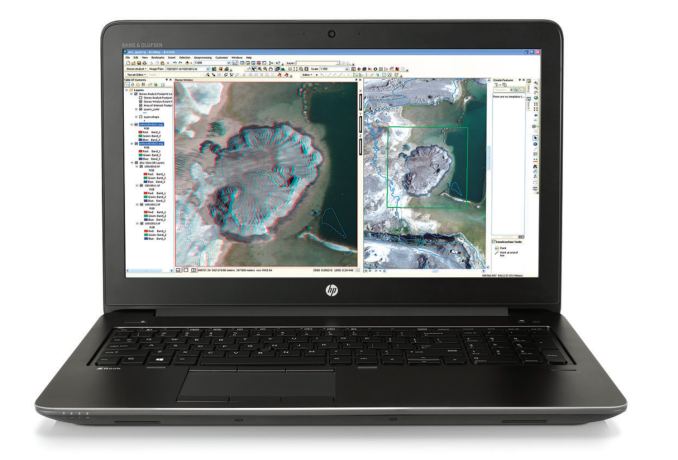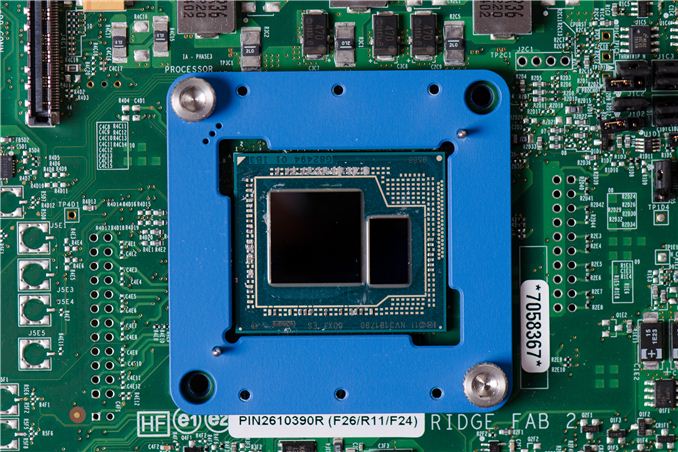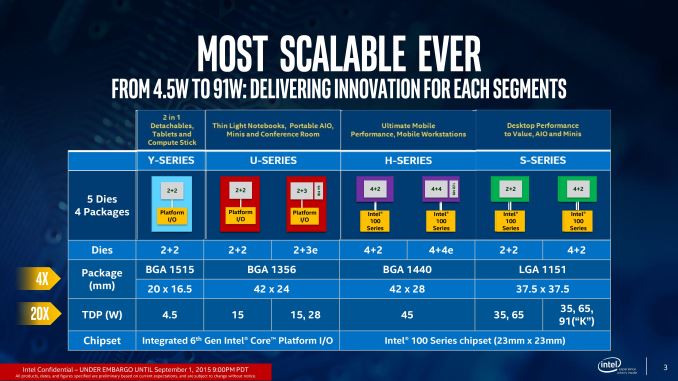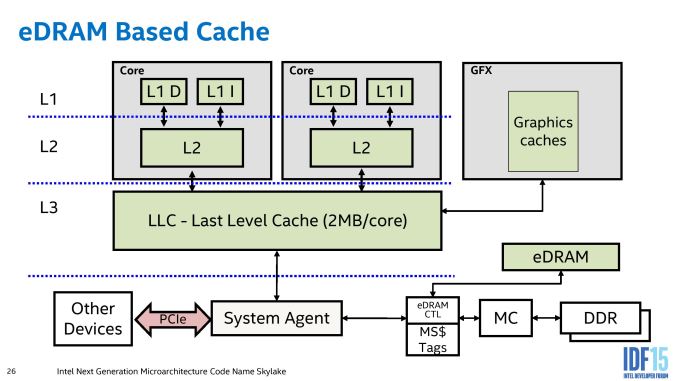Skylake Iris Pro hits Intel’s Pricing Lists: Xeon E3-1575M v5 with GT4e
by Ian Cutress on January 26, 2016 12:17 PM EST- Posted in
- CPUs
- Intel
- Mobile Workstation
- Xeon
- Mobile
- Laptops
- Enterprise
- Skylake
- eDRAM

One of our forum members, Sweepr, posted Intel’s latest pricing list for OEMs dated the 24th of January and it contained a number of interesting parts worth documenting. The Braswell parts and Skylake Celerons were disclosed over the past few months are now available to OEMs, but it’s the parts with Iris Pro that have our attention.
Iris Pro is Intel’s name for their high end graphics solution. Using their latest graphics microarchitecture, Gen9, Iris Pro packs in the most execution units (72) as well as a big scoop of eDRAM. At the minute we assume it’s the 128 MB edition as Intel’s roadmaps have stated a 4+4e part only on mobile, rather than a 4+3e part with 64 MB (only the 2+3e parts are listed as 64MB), although we are looking for confirmation.
The new parts are listed as:
Xeon E3-1575M v5 (8M cache, 4 Cores, 8 Threads, 3.00 GHz, 14nm) - $1,207
Xeon E3-1545M v5 (8M cache, 4 Cores, 8 Threads, 2.90 GHz, 14nm) - $679
Xeon E3-1515M v5 (8M cache, 4 Cores, 8 Threads, 2.80 GHz, 14nm) - $489
These will compare to the non-Iris Pro counterparts, running P530 graphics (4+2, 24 EUs):
Xeon E3-1535M v5 (8M cache, 4 Cores, 8 Threads, 2.90 GHz, 14nm) - $623
Xeon E3-1505M v5 (8M cache, 4 Cores, 8 Threads, 2.80 GHz, 14nm) - $434
As Sweepr points out, the difference between the 2.8-2.9 GHz parts is only $55-56. That is for both the increase in graphics EUs (24 to 72) as well as that extra on-package eDRAM.

The i7-4950HQ with 128 MB eDRAM
We have more reasons to be excited over the eDRAM in Skylake than what we saw before in Haswell with the i7-4950HQ on mobile and Broadwell on desktop with the i7-5775C, i5-5765C and the relevant Xeons. With the older platforms, the eDRAM was not a proper bidirectional cache per se. It was used as a victim cache, such that data that was spurned from the L3 cache on the CPU ended up in eDRAM, but the CPU could not place data from the DRAM into the eDRAM without using it first (prefetch prediction). This also meant that the eDRAM was invisible to any other devices on the system, and without specific hooks couldn’t be used by most software or peripherals.
With Skylake, this changes, the eDRAM lies beyond the L3 and the System Agent as a pathway to DRAM, meaning that any data that wants DRAM space will go through the eDRAM in search for it. Rather than acting as a pseudo-L4 cache, the eDRAM becomes a DRAM buffer and automatically transparent to any software (CPU or IGP) that requires DRAM access. As a result, other hardware that communicates through the system agent (such as PCIe devices or data from the chipset) and requires information in DRAM does not need to navigate through the L3 cache on the processor. Technically graphics workloads still need to circle around the system agent, perhaps drawing a little more power, but GPU drivers need not worry about the size of the eDRAM when it becomes buffer-esque and is accessed before the memory controller is adjusted into a higher power read request. The underlying message is that the eDRAM is now observed by all DRAM accesses, allowing it to be fully coherent and no need for it to be flushed to maintain that coherence. Also, for display engine tasks, it can bypass the L3 when required in a standard DRAM access scenario. While the purpose of the eDRAM is to be as seamless as possible, Intel is allowing some level on control at the driver level allowing textures larger than the L3 to reside only in eDRAM in order to prevent overwriting the data contained in the L3 and having to recache it for other workloads.
We go into more detail on the changes to Skylake’s eDRAM in our microarchitecture analysis piece, back from September.
The fact that Intel is approaching the mobile Xeon market first, rather than the consumer market as in Haswell, should be noted. eDRAM has always been seen as a power play for heavy DRAM workloads, which arguably occur more in professional environments. That still doesn’t stop desktop users requesting it as well – the fact that the jump from 4+2 to a 4+4e package is only $55-$56 means that if we apply the same metrics to desktop processors, an i5-6600K with eDRAM would be $299 in retail (vs. $243 MSRP on the standard i5-6600K).
One of the big tasks this year will be to see how the eDRAM, in the new guise as a DRAM buffer, makes a difference to consumer and enterprise workloads. Now that there are two pairs of CPUs on Intel’s pricing list that are identical aside from the eDRAM, we have to go searching for a source. It seems that HP has already released a datasheet showing the HP ZBook 17 G3 Mobile Workstation as being offered with the E3-1575 v5, which Intel lists as a whopping $1207. That's certainly not the extra $55.
Source: AnandTech Forums, Intel












72 Comments
View All Comments
vcsg01 - Wednesday, January 27, 2016 - link
Not necessarily. Someone doing a budget build that is buying an i3 level processor is not at all likely to splurge on an i7 that is more than twice and maybe 3x the cost to get the intel graphics. They are just going to spend the $50-75 on a dedicated gpu. Adding iris pro to i3 chips may put more money in intels pocket in that case while also taking sales away from dgpu vendors.jsntech - Tuesday, January 26, 2016 - link
I must be missing something, because mobile Core i3/i5/i7 Skylake parts are listed in the referenced Intel document with 'Jan 16' pricing. If I am seeing that correctly, why do you say "Intel is approaching the mobile Xeon market first, rather than the consumer market..."?vcsg01 - Tuesday, January 26, 2016 - link
He's talking about processors with iris pro 580 graphics(gt4e)jsntech - Wednesday, January 27, 2016 - link
Thanks. Guess I got confused by Sweeper's referenced post, where he says:"Now the Iris Pro 580 Core i5/i7 lineup:
i7-6970HQ...
i7-6870HQ...
i7-6770HQ...
i5-6350HQ..."
ltcommanderdata - Wednesday, January 27, 2016 - link
I'm guessing Skylake eDRAM consumer desktop CPUs would require new chipsets/motherboards so is unlikely to happen mid-cycle with Skylake and will instead have to wait for Kaby Lake.In the meantime, I'd be interested if Intel released a faster desktop Broadwell eDRAM CPU as a Devil's Canyon successor. Say 3.8 GHz, full 8MB L3 cache, official DDR3-1866 support, the NGPTIM, and 88W TDP. The Core i7-5775C Broadwell with eDRAM can be just as good as the Core i7-6700K Skylake for gaming despite the lower 65W TDP, so a high-clocked eDRAM Broadwell may well be popular among enthusiasts until eDRAM Kaby Lake's can show up. With Skylake and up only officially being supported in Windows 10 in the long term, a new high-clocked eDRAM Broadwell would also appeal to enthusiasts wanting to maintain a multi-boot Windows 7/8.1/10 system.
Oxford Guy - Wednesday, January 27, 2016 - link
"The Core i7-5775C Broadwell with eDRAM can be just as good as the Core i7-6700K Skylake for gaming"Better. It beats it despite a clock and power consumption deficit.
It's odd that this article didn't mention the gaming performance of the Broadwell C chips, something that makes current desktop Skylake (like 6700K) look rather pointless for a gaming-centric build.
Anato - Wednesday, January 27, 2016 - link
Need ECC, Intel graphics and HDMI 2.0 in mATX. Intel is moving in wrong direction by making Xeons run on only C-series chipsets. For many tasks consumers Z170-series are more abundant and have more features than C-series, they lack ECC thou. C-series is difficult to acquire (in Europe) and most don't have HDMI 2.0 in mATX form.Why can't Z ja Q-series modos support ECC with purchasable code?
Oxford Guy - Wednesday, January 27, 2016 - link
ECC should have been standard on enthusiast platforms for a long time now. The performance hit is minimal in comparison with the benefit.People like to mock Apple but the Apple Lisa from 1983 came with ECC and every chip was individually registered so that if one failed the board would still work fine without it.
One would think that after over 30 years desktop computing would have progressed to the point of surpassing a 1983 desktop.
sfuzzz - Thursday, January 28, 2016 - link
As an example, all AMD FX chips and chipsets natively supports ECC DRAM, the problem lies in MoBo BIOSes, in fact lies in MoBo's manufacture laziness to implement it or not (not many boards support it). Intel was always good at cutting down costs and they know, or were good at convincing the market, that ECC DRAM aren't needed on consumer machines and uses ECC only on "Xeon platforms"Dug - Wednesday, January 27, 2016 - link
Confusing because of wording and graph. The difference between 2.8-2.9 is $190, not $55-$56.I know what you are trying to say. Just pointing out how it may be taken wrong.
As Sweepr points out, the difference between the 2.8-2.9 GHz parts is only $55-56. That is for both the increase in graphics EUs (24 to 72) as well as that extra on-package eDRAM.
And who the hell is going to buy the 1575 @ $1207 over 1545 @ $679. That's a lot of money for 100Mhz.